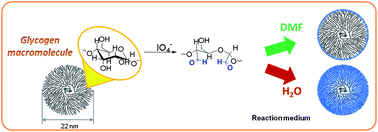Oxidation of glycogen “molecular nanoparticles” by periodate†
Abstract

* Corresponding authors
a
Istituto per i Processi Chimico Fisici del Consiglio Nazionale delle Ricerche (IPCF-CNR), via G. Moruzzi 1, Pisa, Italy
E-mail:
monica.bertoldo@ipcf.cnr.it
Fax: +39 05 0315 2230
Tel: +39 05 0315 2250
b Dipartimento di Chimica e Chimica Industriale, Università di Pisa, via Risorgimento, 35, 56126 Pisa, Italy
c Aziende Chimiche Riunite Francesco Angelini, Piazzale della Stazione, 00040 Pomezia, RM, Italy

 Please wait while we load your content...
Something went wrong. Try again?
Please wait while we load your content...
Something went wrong. Try again?
M. Bertoldo, G. Zampano, L. Suffner, E. Liberati and F. Ciardelli, Polym. Chem., 2013, 4, 653 DOI: 10.1039/C2PY20625K
To request permission to reproduce material from this article, please go to the Copyright Clearance Center request page.
If you are an author contributing to an RSC publication, you do not need to request permission provided correct acknowledgement is given.
If you are the author of this article, you do not need to request permission to reproduce figures and diagrams provided correct acknowledgement is given. If you want to reproduce the whole article in a third-party publication (excluding your thesis/dissertation for which permission is not required) please go to the Copyright Clearance Center request page.
Read more about how to correctly acknowledge RSC content.
 Fetching data from CrossRef.
Fetching data from CrossRef.
This may take some time to load.
Loading related content
